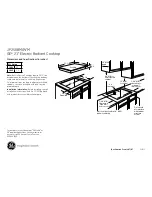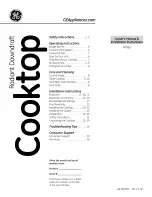
GB
13
• If the cooker is
installed underneath a
wall cabinet, there must
be a minimum distance
of 420 mm between
this cabinet and the top
of the hob.
This distance should
be increased to 700
mm if the wall cabinets
are flammable (
see
figure).
• Do not position blinds behind the cooker or less
than 200 mm away from its sides.
• Any hoods must be installed in accordance with
the instructions listed in the relevant operating
manual.
Levelling
If it is necessary to level the
appliance, screw the
adjustable feet into the
positions provided on each
corner of the base of the
cooker (
see figure).
The legs* fit into the slots on
the underside of the base of
the cooker.
Electrical connection
Install a standardised plug corresponding to the
load indicated on the appliance data plate (
see
Technical data table).
The appliance must be directly connected to the
mains using an omnipolar switch with a minimum
contact opening of 3 mm installed between the
appliance and the mains. The switch must be
suitable for the charge indicated and must comply
with current electrical regulations (the earthing wire
must not be interrupted by the switch). The supply
cable must be positioned so that it does not come
into contact with temperatures higher than 50°C at
any point.
HOOD
420
Min.
min.
650
mm. with hood
min.
700
mm. without hood
mm.
600
Min.
mm.
420
Min.
mm.
Before connecting the appliance to the power
supply, make sure that:
• The appliance is earthed and the plug is compliant
with the law.
• The socket can withstand the maximum power of
the appliance, which is indicated by the data
plate.
• The voltage falls between the values indicated on
the data plate.
• The socket is compatible with the plug of the
appliance. If the socket is incompatible with the
plug, ask an authorised technician to replace it.
Do not use extension cords or multiple sockets.
Once the appliance has been installed, the power
supply cable and the electrical socket must be
easily accessible.
The cable must not be bent or compressed.
The cable must be checked regularly and replaced
by authorised technicians only.
The manufacturer declines any liability should
these safety measures not be observed.
Gas connection
Connection to the gas network or to the gas cylinder
may be carried out using a flexible rubber or steel
hose, in accordance with current national legislation
and any subsequent amendments in force, after
making sure that the appliance is suited to the type
of gas with which it will be supplied (see the rating
sticker on the cover: if this is not the case
see
below). When using liquid gas from a cylinder,
install a pressure regulator which complies with
current national regulations and any subsequent
amendments in force. To make connection easier, the
gas supply may be turned sideways*: reverse the
position of the hose holder with that of the cap and
replace the gasket supplied with the appliance.
Make sure that the gas supply pressure is
consistent with the values indicated in the Table of
burner and nozzle specifications (
see below). This
will ensure the safe operation and durability of your
appliance while maintaining efficient energy
consumption.
Gas connection using a flexible rubber hose
Make sure that the hose complies with current
national legislation. The internal diameter of the hose
must measure: 8 mm for a liquid gas supply; 13
mm for a methane gas supply.
*
Only available in certain models.
The appliance must not be installed behind
a decorative door in order to avoid overheating
Summary of Contents for ACMK 6333/IX
Page 1: ...ACMK 6333 IX ...
Page 35: ...35 ...














































